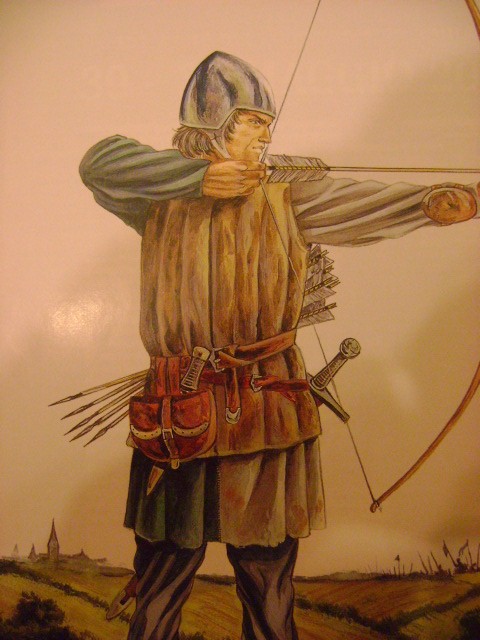Sunday, 14 November 2010
medieval britains archer
The role the Medieval Archers could play in battle was quickly understood, and as early as the years following the Norman Conquest, the practice of archery was much encouraged and the Medieval Archers were granted special privileges. Among the enactments of Henry I of England, it was provided that if anyone practicing with arrows or with darts should by accident slay another, it was not to be visited against him as a crime. 
From 1066 until the end of the 12th Century, the longbow was of the most simple construction. It appears frequently in the Bayeux tapestry. The arrows were usually barbed.


During the 13th Century, besides the mounted men-at-arms or heavy cavalry, there were light troops formed by the mounted archers and crossbow-men. The Medieval Archers were becoming every day of more importance in the field. And, if the bow was an efficient arm in battle, it was still more so in sieges, and the defense of strongholds and mountain-passes.
There was a clear difference between the Continent and England as far as the Medieval Archers are concerned. While the longbow was preferred in England, the crossbow-man was an essential component of a Continental army during all this period. The crossbow-men were either mounted or on foot. One of the popular type of Britains
Britains
Among the Medieval Archers, the English archer is the most prominent character. In the 14th Century, he was equally efficient in siege and in the field. The defender of town or castle could not peep beyond the parapet, but an English arrow could nail his cap to his head. In the field, provided the archers were, by marsh, wood, or mountain, secured from a flank attack, they would bid defiance to any number of mounted men-at-arms. The foot-archers were in far greater proportion then the mounted ones. The bows were of two kinds: painted and plain (white).

Mounted Archer-13th Century
On the continent, the missile weapon employed to oppose the English longbow was still the arbalest (crossbow). The troops who used it were chiefly Genoese and Spanish infantry mercenaries. Mounted crossbow-men were also engaged, but in much smaller numbers. How inefficient the crossbow was when opposed to the English archery appears in every page of the histories of the 14th Century. The element of success was simply the more rapid “fire” of the English archers using the longbow.
Although the 15th Century saw the first hand-gunners, the Medieval Archers were still in favor. The crossbow-men continue to have an important place in the Continental armies of the day. There were also important changes in organizing the Medieval Archers. Learning from the lessons of Crécy and Agincourt, Charles VII of France instituted the French-Archers, equipped partly with the longbow and partly with the crossbow.

From 1066 until the end of the 12th Century, the longbow was of the most simple construction. It appears frequently in the Bayeux tapestry. The arrows were usually barbed.
During the 13th Century, besides the mounted men-at-arms or heavy cavalry, there were light troops formed by the mounted archers and crossbow-men. The Medieval Archers were becoming every day of more importance in the field. And, if the bow was an efficient arm in battle, it was still more so in sieges, and the defense of strongholds and mountain-passes.
There was a clear difference between the Continent and England as far as the Medieval Archers are concerned. While the longbow was preferred in England, the crossbow-man was an essential component of a Continental army during all this period. The crossbow-men were either mounted or on foot. One of the popular type of
Among the Medieval Archers, the English archer is the most prominent character. In the 14th Century, he was equally efficient in siege and in the field. The defender of town or castle could not peep beyond the parapet, but an English arrow could nail his cap to his head. In the field, provided the archers were, by marsh, wood, or mountain, secured from a flank attack, they would bid defiance to any number of mounted men-at-arms. The foot-archers were in far greater proportion then the mounted ones. The bows were of two kinds: painted and plain (white).

Mounted Archer-13th Century
On the continent, the missile weapon employed to oppose the English longbow was still the arbalest (crossbow). The troops who used it were chiefly Genoese and Spanish infantry mercenaries. Mounted crossbow-men were also engaged, but in much smaller numbers. How inefficient the crossbow was when opposed to the English archery appears in every page of the histories of the 14th Century. The element of success was simply the more rapid “fire” of the English archers using the longbow.
Although the 15th Century saw the first hand-gunners, the Medieval Archers were still in favor. The crossbow-men continue to have an important place in the Continental armies of the day. There were also important changes in organizing the Medieval Archers. Learning from the lessons of Crécy and Agincourt, Charles VII of France instituted the French-Archers, equipped partly with the longbow and partly with the crossbow.

Subscribe to:
Comments (Atom)










